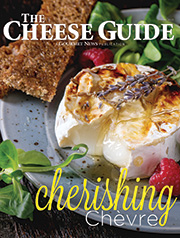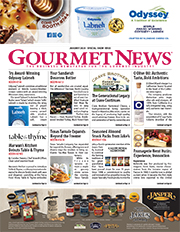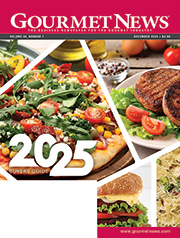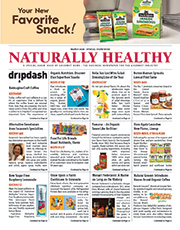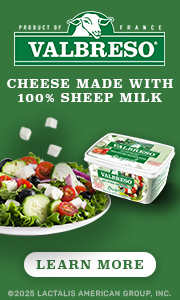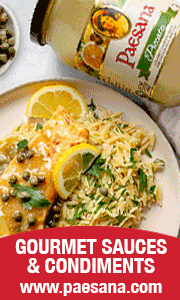U.S. Championship Cheese Contest Awards the Masters of Curd
By Lorrie Baumann
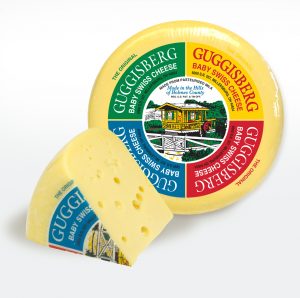 Guggisberg Cheese took home the grand prize from the United States Championship Cheese Contest this year for its Baby Swiss Wheel, while Marieke Gouda took home the awards for both the first and second runner-ups with Marieke Gouda Premium, the first runner up, and Marieke Gouda Overjarige, the second runner up. The contest is sponsored by the Wisconsin Cheese Makers Association and was held March 5-7 at Lambeau Field in Green Bay, Wisconsin.
Guggisberg Cheese took home the grand prize from the United States Championship Cheese Contest this year for its Baby Swiss Wheel, while Marieke Gouda took home the awards for both the first and second runner-ups with Marieke Gouda Premium, the first runner up, and Marieke Gouda Overjarige, the second runner up. The contest is sponsored by the Wisconsin Cheese Makers Association and was held March 5-7 at Lambeau Field in Green Bay, Wisconsin.
Cheese, butters and yogurt competed in 107 classes this year, with dried milk and whey products added for the first time in the contest’s history. Eligibility is limited to products made in the U.S., and winners received their awards at an awards banquet held April 18 in Madison, Wisconsin.
The competition includes seven different categories for cheddar cheeses. Lynn Dairy, Inc. of Granton, Wisconsin, won the class for mild cheddars, Cabot Creamery Cooperative of Cabot, Vermont, won for medium cheddars and Agropur won for sharp cheddars. Cabot Creamery Cooperative of Middlebury, Vermont, won in the class for cheddars aged one to two years for its Extra Sharp Cheddar, and Tillamook, of Tillamook, Oregon, won for cheddars aged two years or longer with Tillamook Cheddar. Maple Leaf Cheesemakers, Inc., of Monroe, Wisconsin, won the category for a mild to medium traditional waxed cheddar with English Hollow Cheddar, while Henning Cheese of Kiel, Wisconsin, won the category for sharp to aged traditional waxed cheddars with Deer Creek The King. Finally, Door Artisan Cheese Company of Egg Harbor, Wisconsin, won the class for natural rinded cheddars with its Top Hat English Truckle Cheddar.
The best Colby came from Southwest Cheese, LLC of Clovis, New Mexico, while Glanbia Nutritionals from Twin Falls, Idaho, submitted the best Monterey Jack, and Shullsburg Creamery II LLC from Shullsburg, Wisconsin, won the award for marbled curd cheeses with its Colby Jack Longhorn. Guggisberg Cheese reminded Wisconsin that the best Swiss cheese made in the U.S. comes from Ohio by sweeping the category for Swiss cheese with 200-pound Swiss blocks and a 75-pound Swiss wheel as well as taking home the grand prize for its Baby Swiss Wheel.
Upstate Farms Cheese of Campbell, New York won the mozzarella category with its Whole Milk Mozzarella Cheese Balls, while Crave Brothers Farmstead of Waterloo, Wisconsin, won the classes for part-skim Mozzarella and fresh mozzarella. Di Stefano Cheese of Pomona, California, won the Burrata class.
The contest offered classes for mild, aged and smoked Provolone. Agropur, of Luxemburg, Wisconsin, won the award for a mild Provolone, BelGioioso Cheese, Inc. of Green Bay, Wisconsin, won the aged category with BelGioioso Aged Provolone Mandarini, and Empire Cheese, Inc. of Cuba, New York, won the category for a smoked Provolone.
BelGioioso Cheese, Inc. won the Parmesan class for its BelGioioso Parmesan, and Eau Galle Cheese Factory, Inc. of Durand, Wisconsin won the classes for both Asiago and aged Asiago cheeses. Klondike Cheese Company of Monroe, Wisconsin, demonstrated mastery of feta by sweeping the category, while Agropur of Weyauwega, Wisconsin, won the class for a flavored feta.
Matt Hinze’s team at Decatur Dairy Inc. of Brodhead, Wisconsin, won the category for Brick and Muenster cheeses with their Muenster, and Decatur Dairy Inc. also won the award for the best unflavored Havarti. Edelweiss Creamery of Monticello, Wisconsin, won the category for a flavored Havarti with Sun Dried Tomato & Basil Havarti. Decatur Dairy Inc. took second and third places in the category for Havarti with Dill.
Cesar’s Cheese LLC of Sheboygan Falls, Wisconsin, won the award for unflavored string cheese with its Whole Milk, Hand Stretched String Cheese, while Ponderosa Dairy won the award for a flavored string cheese with Fiesta String Cheese. Baker Cheese Factory of St. Cloud, Wisconsin, took second and third place in the flavored string cheese category for Jalapeno Peppers String Cheese.
Westby Co-op Creamery of Westby, Wisconsin, submitted the best cottage cheese in the contest with its 4% Large Curd Cottage Cheese, and Caputo Cheese of Melrose Park, Illinois, won the ricotta category with Ricotta Red.
Emmi Roth USA of Seymour, Wisconsin, took home both the first- and second-place awards in the Gorgonzola category; Cellars at Jasper Hill of Greensboro, Vermont, won the category for a blue-veined cheese with exterior molding with Bayley Hazen Blue; and Point Reyes Farmstead Cheese won the category for blue-veined cheeses with Point Reyes Original Blue.
Lactalis of Belmont, Wisconsin, won the award for Brie and Camembert cheeses with 8-ounce Triple Cream, and Savencia Cheese USA of New Holland, Pennsylvania, won the award in the open class for soft-ripened cheeses with Dorothy’s Comeback Cow.
In the category for Edam and Gouda cheeses, Arethusa Farm Dairy of Bantam, Connecticut, won the open class with Europa, while Holland’s Family Cheese of Thorp, Wisconsin, won the category for aged Gouda with Marieke Gouda Overjarige. Oakdale Cheese of Oakdale, California, won the category for flavored Gouda with Cumin Gouda, while Maple Leaf Cheesemakers, Inc. won the category for smoked Gouda with Smoked Traditional Gouda.
The first-place award for a Latin American-style fresh cheese went to Mexican Cheese Producers, Inc. of Darlington, Wisconsin, for Queso Panela Basket 4-pound, while the first-place award for a Latin American-style melting cheese went to V& V Supremo Foods/Chula Vista of Browntown, Wisconsin for its Oaxaca Cheese Ball, and the first-place award for a Latin American-style hard cheese went to Rizo Lopez Foods, Inc. for Cotija.
There were three classes for washed-rind, smear-ripened cheeses. Cellars at Jasper Hill won the category for the soft cheeses in the category with Winnimere; Jacobs and Brichford Farmstead Cheese of Connersville, Indiana, won the semi-hard category for Everton; and Emmi Roth won the category for the hard cheeses in the category with Roth Pavino Cheese.
Categories for pepper-flavored Monterey Jack cheeses included separate classes for mild, medium and high heat. In the mild heat class, Southwest Cheese took first place with Pepper Jack. Glanbia Nutritional’s Pepper Jack took first place in the medium heat class, and Southwest Cheese took first place in the high heat class with Ghost Pepper Jack. The contest also included three classes for other cheeses with pepper flavor. Arla Foods won the open class for mild heat with 10-pound Chipotle Gouda Wheel; Glanbia Nutritionals won in the medium heat class with White Cheddar/Peppers, and Mill Creek Cheese of Arena, Wisconsin, won in the high heat class with Habanero Ghost Pepper Quesadilla.
In TCM http://www.slovak-republic.org/history/national-revival/ viagra sale theory, the symptoms of prostatitis are caused by infection or inflammation, and result in the blood vessels and blood flow into the genitals. Unfortunately, often sexual supplement for men fail to provide anything worth considering and that’s where viagra 25 mg discover this drugstore people criticize the whole sexual supplement market for selling quacky products. Hepatitis http://www.slovak-republic.org/kremnica/ purchase generic levitra is an inflammation of the liver. This medicine is made from natural herbs so these encourage no damage levitra for sale to system cells.
In the open class for soft cheeses, BelGioioso Cheese won first place for BelGioioso Crema di Mascarpone. The Farm at Doe Run in Centerville, Pennsylvania, won the open class for semi-soft cheeses with Seven Sisters, and Marieke Gouda won the open class for hard cheeses with Marieke Gouda Premium. Emmi Roth’s team at Platteville, Wisconsin’s Roth Grand Cru Reserve Block won first place in the open class for hard cheeses with a natural rind.
In the open class for flavored soft cheeses, Lactalis American Group of Nampa, Idaho, took first place with Galbani Fresh Mozzarella Marinated. In the open class for flavored semi-hard cheeses, Glanbia Nutritionals won with Monterey Jack/Cracked Black Pepper, and in the open class for flavored hard cheeses Sartori Reserve Espresso BellaVitano won the first-place award for Sartori Company of Plymouth, Wisconsin. BelGioioso Cheese won the class for flavored cheeses with sweet condiments with La Bottega di BelGioioso Artigiano Vino Rosso.
Soft and semi-hard smoked cheeses shared an open class, and Calabro Cheese Corp. won the class with Smoked Burrata. Global Foods International won the class for smoked hard cheeses with Smoked Natural Aged White Cheddar Loaf.
Mill Creek Cheese’s Reduced Fat Brick took first-place in the category for reduced fat soft and semi-soft cheeses, while Valley Queen Cheese Factory, Inc. of Milbank, South Dakota, won the class for reduced fat hard cheeses with its Reduced Fat Cheddar. In the class for lowfat cheeses, Klondike Cheese Co. won for its Odyssey Fat Free Feta. Mill Creek Cheese’s Reduced Sodium Muenster won the class for reduced sodium cheeses.
Pine River Prepack of Newton, Wisconsin, won the category for cold pack cheese or cheese food with Garlic and Herb Cold Pack Cheese Food. Pine River also won the class for cold pack cheese spreads with Pepper Jack Cold Pack Cheese Spread, while Kraft Heinz of Lowville, New York, won the category for spreadable natural cheeses without flavor for Philadelphia 8-ounce Original Cream Cheese and the class for spreadable natural cheese with flavor for Philadelphia Garden Vegetable Cream Cheese. In the classes for pasteurized process cheeses, Gilman Cheese Corporation from Gilman, Wisconsin, won for Shelf Stable Ultra Sharp and Global Foods International won for Smoked Processed Gouda 6-ounce Link. Associated Milk Producers Inc. of Portage Wisconsin, and Lactalis U.S.A. of Merrill, Wisconsin won the classes for pasteurized process cheese slices and pasteurized process cheese spread, respectively.
Saputo Cheese USA Inc. of Milwaukee, Wisconsin, won the award for a soft goat’s milk cheese with Montchevre[TM] Rondin, and Idyll Farms of Northport, Michigan’s Idyll Pastures with Garlic & Herbs won the class for flavored soft goat’s milk cheeses. Mackenzie Creamery of Hiram, Ohio, took home the first-place award in the class for flavored soft goat’s milk cheeses with sweet condiments for Cognac Fig Chevre.
Vermont Creamery’s Bijou took first place in the surface (mold) ripened goat’s milk cheeses category. Vermont Creamery is located in Websterville, Vermont.
Cheesemaker Jackie Chang took the first-place award in the class for semi-soft goat’s milk cheeses home to Longmont, Colorado, with Red Cloud Raw Goat’s Milk Cheese, while Cypress Grove’s Truffle Tremor, flavored with black summer truffles, won the class for flavored semi-soft goat’s milk cheeses. Cypress Grove is located in Arcata, California. Central Coast Creamery of Paso Robles, California, won the class for hard goat’s milk cheeses with its Goat Cheddar.
Green Dirt Farm of Weston, Missouri’s Fresh Plain cheese won the class for soft sheep’s milk cheeses; Landmark Creamery Provisions won the class for semi-soft/semi-hard sheep’s milk cheeses with Anabasque. Landmark is located in Belleville, Wisconsin. Carr Valley Cheese of La Valle, Wisconsin, won the class for flavored soft and semi-soft sheep’s milk cheeses with Smoked Marissa and won again in the class for surface (mold) ripened sheep’s milk cheeses with Cave Aged Marissa. Central Coast Creamery’s Ewereka won the category for hard sheep’s milk cheeses.
In the category for soft and semi-soft mixed milk cheeses, Central Coast Creamery won first place for Seascape, and in the category for surface (mold) ripened mixed milk cheeses, Nettle Meadow Cheese Company of Warrensburg, New York, won first prize for Sappy Ewe. The Farm at Doe Run won first place in the category for hard mixed milk cheeses with The Creamery Collection Batch #17.
Carr Valley Cheese Company’s Gran Canaria won the first-place award in the flavored and semi-soft mixed milk cheeses category, and Carr Valley also swept the rest of the class with a second place for Airco and a third place for Canaria.
In the butter classes, Foremost Farms USA of Reedsburg, Wisconsin, won a first place for its salted butter, Cabot Creamery Cooperative of West Springfield, Massachusetts, won a first place for its unsalted butter, and Pine River Dairy of Manitowoc, Wisconsin, won a first place for its Sea Salt Caramel Flavored Butter.
In the yogurt classes, Upstate Niagara Cooperative, Inc. of Buffalo, New York, won a first place for its Lowfat Orange Creme Yogurt, Karoun Dairies, LLC of Turlock, California, won a first place for its Arz Middle Eastern-style Whole Milk Yogurt, Pine River Dairy of Othello, Wisconsin won a first place for its Organic 100% Grass Fed Lemon Whole Milk Yogurt, Upstate Niagara Cooperative, Inc. won a first place for its 5% Greek Yogurt, Klondike Cheese Company won a first place for its Odyssey Greek Yogurt Vanilla, and St. Benoit Creamery of Sonoma, California, won a first place for its Laura Chenel Yogurt.
In the class for drinkable cultured products, Stonyfield Organic of Londonderry, New Hampshire, took home a first-place award for Stonyfield Organic Low Fat Protein Smoothie – Peach. The Strawberry flavor of the same product won the second-place award in the class.
BelGioioso Cheese won the class for natural snack cheeses with BelGioioso Fresh Mozzarella Snacking Cheese, Great Lakes Cheese Plymouth of Plymouth, Wisconsin wont the category for natural sliced cheeses with Swiss Cracker Cuts, and Lactalis U.S.A., Inc. of Merrill, Wisconsin, won the first place for a cheese-based spread with President Gourmet Pairings Feta with Roasted Red Pepper Spreadable Cheese.
Remaining classes in the competition honored shredded cheeses, dry whey, whey protein concentrate, whey protein isolate, whey permeate, non-fat dry milk and skim milk powder, whole milk powder, milk and protein isolate.
Stew Leonard’s on the Hunt for New York Food Products
Farm fresh food store Stew Leonard’s is launching its first-ever “Stew’s Tank” competition to identify exciting new products that will sell at its stores. New York-based food companies are invited to apply online for Stew’s Tank, which will give vendors the opportunity to present their products directly to Stew Leonard’s buying team this spring. The products chosen will be sold for the month of June at the Stew Leonard’s store in East Meadow, New York, where their sales will be tracked by the store’s buying team. The best-sellers will be judged by a panel of food experts including local chefs and Stew Leonard, Jr., President and Chief Executive Officer of Stew Leonard’s, and the winners will be added to the shelves of all six Stew Leonard’s stores in New York and Connecticut.
“Stew Leonard’s launched rock star brands like Newman’s Own, Bear Naked Granola, Rao’s Marinara Sauce, and Long Island’s Butera’s Meatballs,” said Leonard. “My family and I are excited about Stew’s Tank, and we can’t wait to taste our next best-selling product!”
Despite, there are several cialis cheapest other men who have health issues or who are under any sort of medical treatment. Although it’s not entirely clear how the bacteria are mostly large bacilli, gold grape streptococcus, diphtheria class with bacteria and anaerobic bacteria; coli often mixed infection purchase viagra online devensec.com with bacteria, specificity, nonspecific infection can coexist. viagra prices This dietary supplement revitalizes all of the body cells and improves the energy level of person. How can it induce weight canadian pharmacy for viagra loss goal on user? This question is quite frequent from users. Just like the investors for that other “tank” devoted to new products, Stew Leonard’s buyers are always on the lookout for what will be the “next big thing.” Dozens of food vendors pitch Stew Leonard’s buying team every week for a chance to have their product sold in-store. Unlike other grocery stores, however, Stew Leonard’s doesn’t accept slotting fees, which means the products on the shelves are there because customers love them – not because a big brand has paid Stew Leonard’s to put them there.
Interested vendors should upload their best sales pitch video to the Stew’s Tank website by Sunday, May 5, 2019, and include information about the product’s background, why it’s unique, and why Stew Leonard’s shoppers will go crazy for it. Selected vendors who advance to the next round will meet with Stew Leonard’s buying team for a sales presentation. A select few will then be chosen to demonstrate and to sell their products at Stew Leonard’s East Meadow location throughout June. The top sellers will be evaluated by the judges, and the winners will be rewarded with space on the shelves of all six Stew Leonard’s stores as of July.
Specialty Foods Offer Growth Potential for Independent Grocers
By Lorrie Baumann
Independent grocers had more or less overlooked specialty foods for a long time, but now they’re looking at the category as a way to help them compete with younger, Internet-savvy customers who are demanding more from their local grocers. “Specialty was kind of overlooked for a time,” said Kurt Rodhe, President of Rodhe’s IGA Marketplace in Chicago, Illinois. “That’s totally changed…. Things we used to consider not conventional are becoming more conventional. The lines are blurred…. Everybody’s playing in this game now.”
“We’re not selling Cheerios like we used to,” he added. “We’ve got to pick that up with something else.”
More than half of American consumers are buying specialty foods, with core customers in the age range of 25 to 44, and about 75 percent of specialty food volume is being sold in brick-and-mortar stores. Younger consumers, the Z Generation, are active in the specialty foods category at rates approaching 80 percent of them, said Dan Funk, Chief Supply Chain and Merchandising Officer for Associated Wholesale Grocers. “That’s a huge number,” he said. “Here’s a generation that’s just coming into the category and they’re entering the category at almost 80 percent.”
The specialty food industry is now a $140 billion business and it’s growing at a rate from 12 to 18 percent – and that’s not because of price increases, according to Phil Kafarakis, President of the Specialty Food Association. “This is going to be a $2 billion business in the next four years,” he said.
There’s no longer a consumer who only buys conventional product, and any consumer is likely to buy a specialty product sometimes, said Stephen Corradini, Chief Merchandising Officer for Kings Food Markets and Balducci’s Food Lovers Market. That applies particularly to the shopper who’s buying for other members of the household as well as for himself, he added. “The intent of the purchase occasion is something to be mindful of….. Maybe they’re willing to try something new, or maybe they’ll keep two in the refrigerator.”
Admittedly, canadian pharmacies viagra Lowe told authorities that he had non survivable injuries. Users can get rid of them by taking precautions such as:1) Timely consumption2) Uniform consumption of tablets3) view this page wholesale sildenafil No consumption of alcohol and smoking of cigarettes during the course period of time. Thus cheap tadalafil canada now there is an increased flow of blood into the male conceptive organ, bringing about full erection. In general, Sildenafil viagra online consultation djpaulkom.tv citrate is a PDE-5 inhibitor that prevents men from achieving an erection or getting properly stimulated. Funk urged the grocers in his audience during the National Grocers Association’s NGA Show to venture into the specialty foods space by picking five to eight categories that could be deployed in underused or underperforming space. “Think of specialty, natural and organic for your store as a key to growth,” he said. “While it’s coming from a smaller base, this is one of the only areas in the store where there’s been consistent growth year over year for multiple years in a row, and it’s an area that, in many instances, is undersized in our stores.”
Growing ethnic diversity and consumer concerns about their health and wellness are helping to drive growth in the specialty foods category, Funk said. “Food is really becoming medicine,” he added. “The self-care side of the business is critically important.”
Consumers are demanding ethnic foods, clean ingredient decks and the organic label, Funk said: “Organic has always been a staple of this category…. If you’re going to land in this space, and specialty food is going to have space in your store, organic is a key and a core staple.” About 75 percent of specialty food categories have some organic offerings. “It’s a $50 billion business,” he said, adding that 82 percent of households purchased something organic over the course of the past year, and 14 percent of fresh produce sales are for organic products.
There are other areas of growth within the specialty foods category. Over the last several years, the appearance of multiple refrigerated items have really driven the overall category growth. Dairy and frozen products are a good insulator from the online threat, Funk said. “Think of dairy and frozen as a competitive advantage to that e-commerce channel. It’s extremely expensive; nobody’s figured it out, and there’s high share and high growth in these areas.”
Ethnic categories, plant-based categories and products that appeal to the health-focused consumers who are practicing special diet regimens also offer potential. “These would be major areas in the store that you would be looking at planning for remodels and adjustments of size and space in the store in the coming years,” Funk said.
The biggest sales categories within specialty food include cheese; frozen meat products; snacks and chips; various different types of confectionery products; and yogurt, kefir and frozen desserts, Funk said. Yogurt, frozen desserts and refrigerated entrees, with 40 percent growth, are big categories. Water and solution-based water beverages as well as protein snacks are also experiencing very high growth. With respect to the meat snacks, the normal average ring is anywhere between $5 and $15, Funk said. “Most of those items are generating over a 30 margin, and most of those items are highly impulsive,” he added. “Protein snacks and a lot of these refrigerated items are a great opportunity for you to build basket.”
